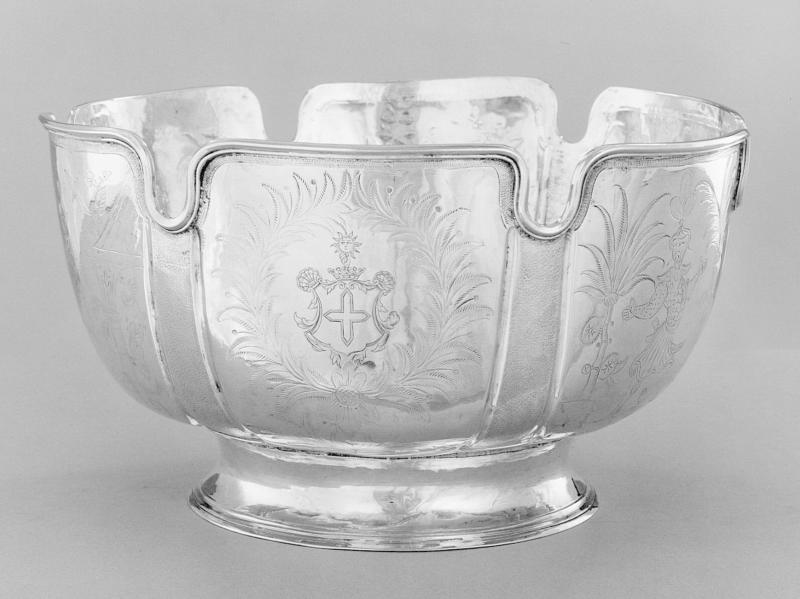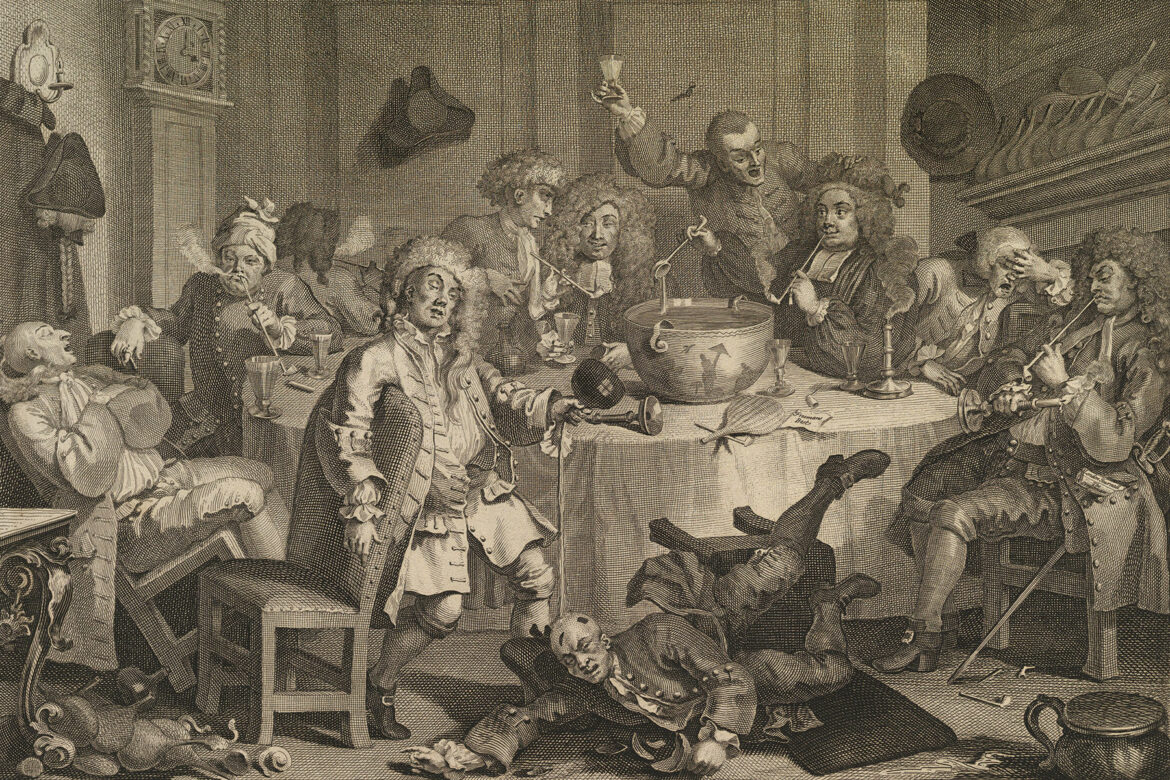HISTORY + HOLIDAY DRINKING
The Highs and Lows of the Perennial Party Drink
My introduction to punch might have been a lot like yours. SCENE: the Daniel Webster Elementary School gymnasium. DATE: sometime in the late 20th century. ACTION: I am looking at a plastic hemisphere big enough for my 8-year-old self to sit in; its exterior is textured to resemble cut crystal, and it is filled with many, many 2-liter bottles of 7UP. Inside—looking like a psychedelic iceberg cleaved from a Lilly Pulitzer polar cap—floats a half gallon brick of Sealtest sherbet. The result is fruity, fizzy, creamy; the irrefutable message is “party.”
I tell this story only to illustrate that punch, even in degraded form, remained a party essential 400 years after its inception, and that this PTA version shared qualities with its 17th-century origins. At base, punch is a way to both tame and stretch spirits—it’s about economy, just like that cheap 7UP/sherbet concoction that slaked the thirst of a thronged gym.
Let’s say it’s the year 1680 and you’re going to throw a party, but you can’t afford expensive bottles of imported wine—what to do? Well, you get yourself a measure of cheap navy-strength rum (sold at a hair-curling 57% ABV), then add lemon, maybe some nutmeg and sugar and, most important, a whole bunch of water. The result—in its ABV, in its acidity, in its fruitiness—is a reasonable alternative to wine. Plus, it’s an idea can be interpreted in limitless ways.
Punch is perfectly of its time; it’s a drink about colonization. The rum came from the Caribbean, as did the sugar, as did much of its citrus, which had been introduced to the West Indies by European colonists. Its spices came courtesy of the East India Company which controlled the exports of much of India and Asia. And all were brought to you under the protection of the British navy.
Despite thrifty origins, punch was embraced by the wealthy in the 18th century; they interpreted punch’s basic elements through their deeper pockets. If you were in this realm, your punch would have contained expensive wines, fresh citrus, and rarefied spices, and would have been ladled from ostentatiously ornate silver punchbowls called monteiths whose circumferences were notched to hold the stems of equally fine glasses. And guess what? The punch attributed to Daniel Webster Elementary School’s namesake contained neither 7UP nor Sealtest sherbet. Instead, as recorded in 1869, “Daniel Webster Punch” was laden with—along with rum, sugar, and lemons—baller-worthy oloroso sherry, cognac, Bordeaux wine, and champagne. We in the gym were robbed.

Many historians cite the British navy as the inventors of punch—and you can bet that the military division spurred by “rum, sodomy, and the lash” (thanks, Winston Churchill) was interested in economy. When Britain colonized the sugar-producing Caribbean islands (and began distilling rum from molasses, a co-product of sugar refining), the Royal Navy swapped its sailors’ daily ration of one gallon of ale for one pint of rum. Navy-strength rum took up less cargo space because it was a concentrate: It was given to the sailors as grog, that is, heavily watered and dosed with lime juice to prevent scurvy. If you were poor in England or the United States, the punch you drank was probably similar—though you likely skipped pricy citrus and dressed it up with ale, sugar, or egg. To this day, Planter’s Punch—rum, water, citrus—echoes the grog that fueled Britannia’s run to rule the waves.
Charles Dickens was uniquely suited to describe the punch habits of both the rich and poor. As a child, owing to his father’s imprisonment for debts, he was pulled from a school for young gentleman and sent to work in a factory. Later, his wildly popular novels made him an international pop star—and he enjoyed the wealth that he’d earned. In David Copperfield, Dickens’s semi-autobiographical bildungsroman, an uncharacteristically depressed Wilkins McCawber—chronically indebted, yet perennially hopeful—is revived by the celebratory ritual of making punch:
I never saw a man so thoroughly enjoy himself amid the fragrance of lemon-peel and sugar, the odour of burning rum, and the steam of boiling water, as Mr. Micawber did that afternoon. It was wonderful to see his face shining at us out of a thin cloud of these delicate fumes, as he stirred, and mixed, and tasted, and looked as if he were making, instead of punch, a fortune for his family down to the latest posterity.
I do know the name of the nice lady who, at every Webster PTA event, produced her signature punch. And I hope that her family serves it at their holiday celebrations right down to the latest posterity.
Charles Dickens’s Punch Recipe
Adapted from Punch by David Wondrich
Dickens shared his recipe for punch in a letter written in 1847; at that point he’d published The Pickwick Papers and A Christmas Carol—both giant hits—but was yet to write David Copperfield, A Tale of Two Cities, and Great Expectations. Which is to say, the point when Dickens’s success could be hoped for, but was in no way guaranteed.
YIELDS: 2 QUARTS
INGREDIENTS
¾ cup sugar (preferably demerara)
3 lemons, peeled and juiced
2 cups rum
1 ¼ cups cognac
5 cups black tea (or hot water)
Garnish: lemon and orange wheels, freshly grated nutmeg
DIRECTIONS
In an enameled cast-iron pot with a lid, add sugar and the peels of 3 lemons. Rub lemons and sugar together to release citrus oils, then let sit for 30 minutes. To this add rum and cognac, then use a stainless-steel spoon to lift some of the spirit mix. Use a match to flame it, then lower the spoon to the rest of the mixture in the pot. Allow mixture to burn for about 3 minutes; this will melt the sugar and extract the oil from the peels. Cover the pot with the lid to extinguish the flame, then remove the lemon peel. Add the lemon juice and hot tea or water. Serve either hot or chilled, ladled into glasses and garnished with citrus wheels and grated nutmeg.
INTERSECTION PLAYLIST
Pack a Punch
MUSIC FOR A KILLER PARTY
Victoria Reis is a curator and writer championing the arts through exhibitions and programs. As co-founder of Transformer, she connects artists, many NYC-based, to broader audiences. Check out transformerdc.org.



